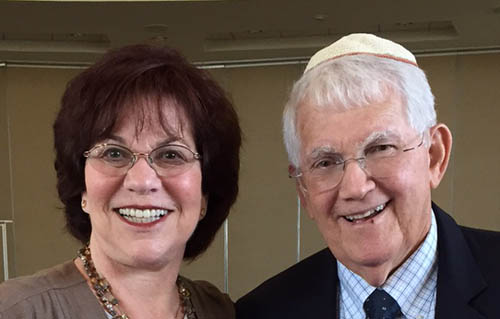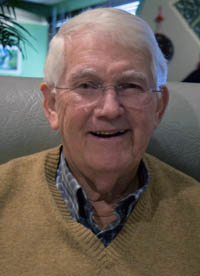By Donald H. Harrison


SAN DIEGO — Sitting across a table from Ed Cherlin, you notice that he is a man with patience who doesn’t show even a flicker of annoyance when an interviewer changes the topic, or interrupts his answer. This probably is because Cherlin also is a man with patients – psychiatric ones, with whom he has spent a good portion of his career helping to calm down.
It’s hard to imagine this contemplative, reflective, golf-playing, book reviewing, amiable semi-retiree ever losing his cool, or feeling stressed, but perhaps that was because our meeting was at a comfortable restaurant in his hometown of San Diego, not in New York City, where he did one year of residency at Bellevue Hospital. He told me he couldn’t get out of New York fast enough.
He recalled that back then he and his wife, Sue, just had their first of three daughters–Caryn—and that they felt confined in a small apartment at 30th Street and 1st Avenue in Manhattan. Except for his trips back and forth to Bellevue Hospital on the East River, he and Sue never seemed to get out. “I was used to roaming around and getting out and I couldn’t go anywhere,” Cherlin said.
While a psychiatrist can see all kinds of patients at Bellevue—particularly violent ones—they too can be unsettling for a man who likes peace and quiet and reflection. At Bellevue, Cherlin said “the patient population is the world’s worst as far as pathology goes. It was a good place to train. We would be on call every so often. We would be in the emergency room and there would be between 10 and 20 people coming in, some of them extremely sick. One of our residents nearly died: he got stabbed in the back by one of the patients.”
As his first year of a three-year residency neared conclusion, Cherlin made a decision. To get out of New York City. “I recognized I was getting stressed and I said I just am not going to do this.”
So he transferred to Hartford, Connecticut, where he had been born but had left while still in the lower grades of elementary school. He had family there, and the atmosphere at The Institute of Living was far more subdued than that of Bellevue. The Institute treated celebrity clients for alcohol and chemical dependencies, as well as psychiatric patients. The head of the Institute served as an editor of the Green Journal, a publication of the American Psychiatric Association.
In the comfort of Hartford, Cherlin’s and Sue’s second daughter, Debbie, was born.
Once Cherlin completed his residency, he joined the Public Health Service, which was an alternative to the Armed Forces. He was assigned as a psychiatrist to a federal facility at El Reno, Oklahoma. Patients there included “car thieves, drug users, not hardenCed criminals,” Cherlin recalled. Years after Cherlin left the U.S. Public Health Service, Timothy McVeigh was imprisoned there after the Oklahoma City bombing.
Once Cherlin’s hitch was up, the family moved to San Diego, where their third daughter, Becky, was born.
Coming to San Diego meant Cherlin was home again.
Cherlin had attended Linda Vista Elementary School, Pacific Beach Junior High School, and was a member of the first graduating class of Mission Bay High School. “Being the first class, we named the team ‘the Buccaneers’ and selected the school colors of black and gold.” One of his classmates was Roland Dale Weber III, who was an heir to the Weber Bread Company fortune. “He was the nicest guy,” Cherlin recalled. “We were on the golf team together.” The golf team played at the La Jolla Country Club, among others, and “in those days no Jews were allowed to buy property in La Jolla. I got a kick out of playing at their country club.”
Cherlin often helped his father George, owner of Cherlin Scrap Metal, which was located on Morena Boulevard. “I went on some calls for pickup of aluminum and aluminum castings, steel, and iron, and it was not easy work. It was very heavy stuff.” Cherlin’s mom, Betty, meanwhile, worked as a secretary at Convair.
Cherlin had his bar mitzvah at Tifereth Israel Synagogue when it was located at 30th and Howard Streets. Some years later, his father was instrumental in helping to start Congregation Beth El in Clairemont. Similar to Tifereth Israel’s decision to move to San Carlos, Beth El subsequently decided to move to La Jolla.
Always interested in science and biology, Cherlin majored in zoology at San Diego State University, where he was a member of the then-Jewish Zeta Beta Tau (ZBT) fraternity. ZBT’s advisor was History Prof. Abe Nasatir, for whom Nasatir Hall at SDSU later was named.
After SDSU, Cherlin went to Medical School at the University of Cincinnati where he courted his future wife Sue, who then was an undergraduate studying to be an elementary school teacher. While each of them were on dates with other people, they met on a wintery Saturday night at the Cincinnati Symphony at a program featuring violinist Edith Peinemann. The orchestra also performed “The Moldau” by Smetena, which ever since, has been a favorite of the couple. Immediately after Cherlin completed his last year of medical school, they were married on June 20, 1965. As Sue still had a year to go to finish her undergraduate degree, Cherlin decided to do his internship at Cincinnati General Hospital. A week after Sue graduated, their first daughter, Caryn was born.
Later, when the family was settled into the familiar and comfortable surroundings of San Diego, Cherlin grew a private practice with offices in San Diego and in El Centro. Mondays, Wednesdays and Fridays meant San Diego; Tuesdays and Thursdays meant a long but soothing ride to El Centro listening as he drove to books on tape.
A significant portion of Cherlin’s career was spent researching the effects of medications produced by pharmaceutical companies to combat Attention Deficit Hyperactivity Disorder (ADHD) in children.
Under the guidance of the Food and Drug Administration, he was among numerous doctors throughout the United States who administered “double blind” tests of such medicines as Strettera, Intuniv and Vyvanse to children and then carefully reported the results.
Cherlin said that ADHD “is broken down into three separate categories: ADHD Inattentive Type; ADHD Hyperactive Type, and ADHD Combined.” Patients in the “Inattentive” category have problems with getting their work finished, being distracted making careless mistakes.” Those in the Hyper category, “can’t stay seated; they are loud; they are intrusive; and they are running around all the time – much more than you would expect of a kid who is simply hyper. The parents come in pulling their hair out, saying ‘I can’t keep Johnny in place for two seconds; he is paying no attention to anything. I think he is bright, but he is failing in school and I get notes all the time.’” The Combined category includes patients who exhibit both sets of symptoms.
A “double blind” test is one in which neither the doctors nor the patients know which patients have received the experimental medication and which have received placebos. (The doses look alike). There are between 10 and 20 patients in a typical study; with perhaps 50 studies being conducted simultaneously around the United States. “With ADHD, there were various scales to evaluate children’s behavior,” Cherlin said. “Are they more attentive? Are they less restless? Is their ability to focus better?”
There is something researchers call the “placebo effect” in which “if you do a study with 100 people and you give everyone a placebo (typically a sugar pill), 30 percent of them will say their condition is improving.” What the clinical trials try to determine is whether the medication under scrutiny outperforms the placebo.
In some studies of children with ADHD, researchers could make educated guesses who got what “because if you have a kid who is all over the place, and can’t sit still and is not paying attention, and then after two or three weeks he is sitting still, and paying attention, you are pretty sure that it is not a sugar pill doing this.”
Cherlin said medical researchers believe there is a genetic component to ADHD. “We don’t know what it is but we believe in time we will find a genetic relationship.”
Medication alone is not sufficient to deal with ADHD, Cherlin said. “Parents need to be educated to what it is, how to deal with kids, how to give them appropriate time outs and how to deal with various things that come up — in a more constructive way than hitting them across the head or whatever the parents used to do.”
Cherlin said that in some cases children simply will grow out of ADHD. “In their adult years, they develop an ability to maintain,” he said. “The brain develops over the first 15 years or so of your life. I was just reading an article (in a medical journal) about the differences between a 7-9 year old’s brain and a 15-16 year old’s brain. Maybe with a certain amount of maturity, it helps modulate the situation and make life easier for these people.”
Cherlin thought that he had retired in 2011. But a fellow psychiatrist in Temecula prevailed upon him to drive up the Interstate 15 once a week to supervise ongoing clinical trials up there. Like his previous commutes to El Centro, the drive up the 15 can be quite soothing—as it is in the opposite direction of the rush traffic. On the ride, Cherlin has plenty of time to think about the fiction and non-fiction that his book club is reviewing, or about an upcoming golf match, or about his role as the Communications Committee chairman for the Tifereth Israel Synagogue Men’s Club.
*
Harrison is editor of San Diego Jewish World. He may be contacted via donald.harrison@sdjewishworld.com . Comments intended for publication in the space below must be accompanied by the letter writer’s first and last name and by his/ her city and state of residence (city and country for those outside the U.S.)
